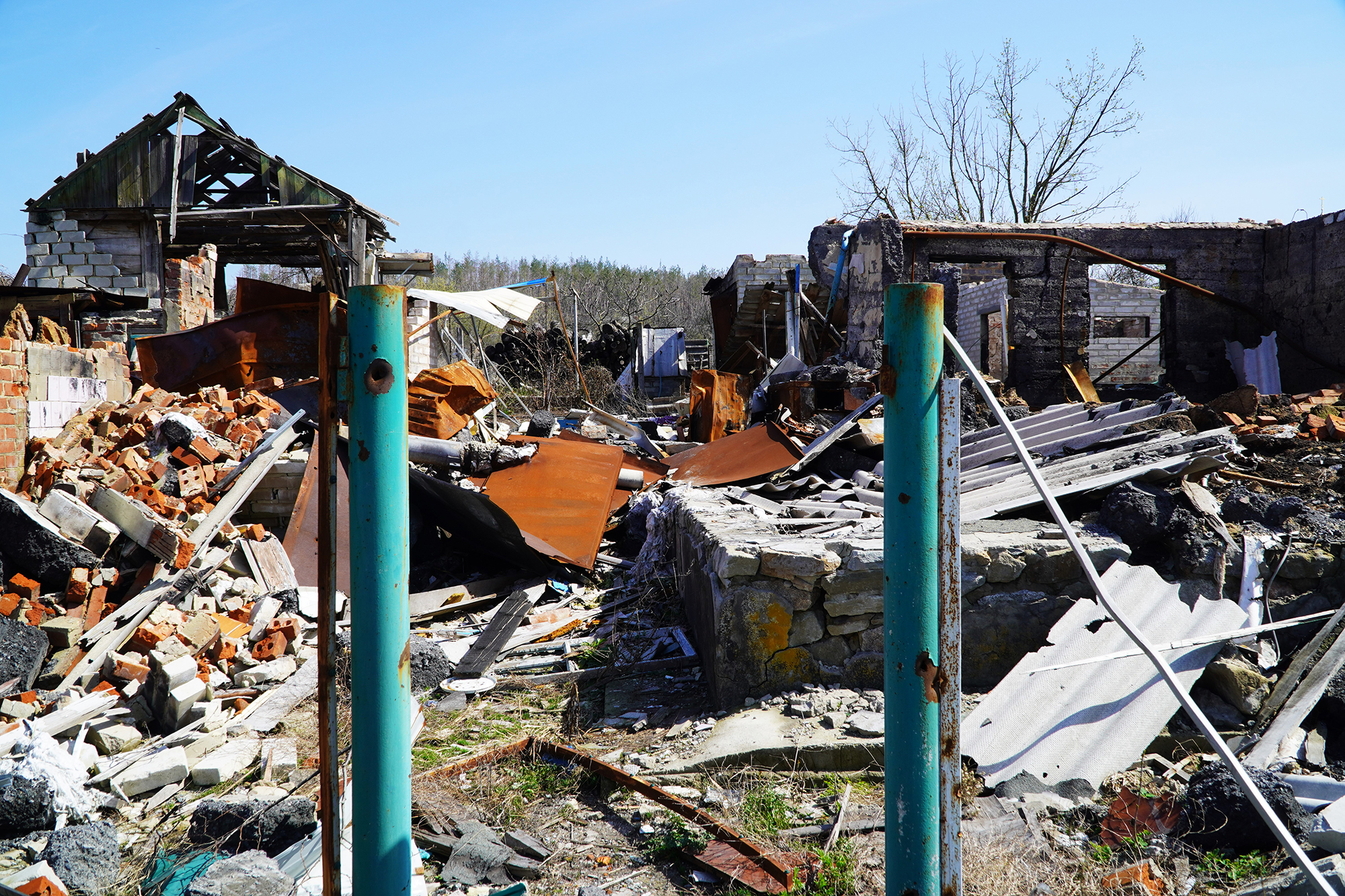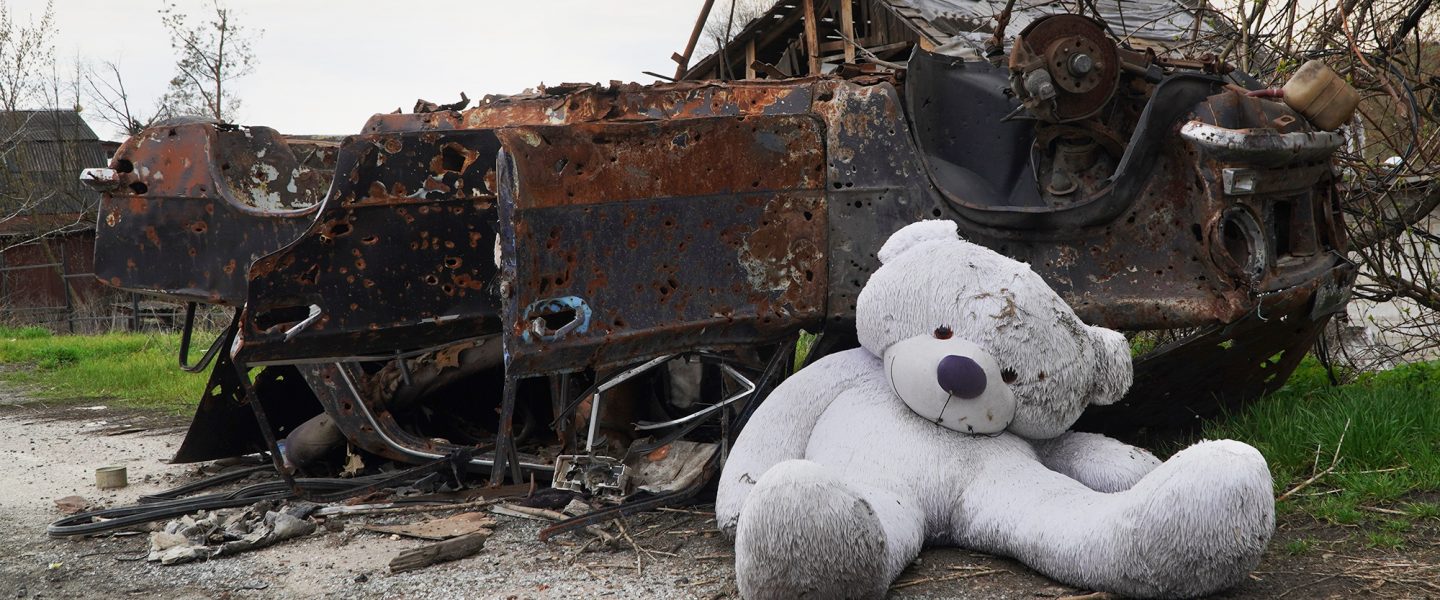Only seven of the 600 pre-war inhabitants of the village of Bohorodychne in eastern Ukraine remain. They live surrounded by ruins and unmarked graves.
|
Listen To This Story
|
BOHORODYCHNE, Ukraine — Only a few naked and partly destroyed walls are still standing of what was once the home of 58-year-old Halyna Reshetnyak and her husband, Sergey. Broken tiles and bricks lay scattered around after an artillery shell ripped their house to pieces last year.
“Everything was burning. It was chaos,” explains Halyna, who evacuated when the Russian army began an assault on her village in eastern Ukraine last summer. “Almost no one decided to stay. It was impossible to hide from the war here.”
Halyna points to the neighboring houses to make her point. They have all suffered the same destructive fate. Only burned ruins remain, along with a few scattered belongings. No homes in Bohorodychne stand untouched after the Russian invasion of the village, which was liberated by Ukraine in September after having switched hands about 14 times.

Empty Russian ammunition boxes, fragments from artillery shells and blown-up tanks, and unexploded mines are everywhere as a reminder of the Russian assault on the village. Bohorodychne is known for the Ukrainian Orthodox church which overlooks the city, which is now partially destroyed. In English, Bohorodychne means “Where God was born.” Only seven people live here now. Before the invasion, there were 600 residents.
The Ukrainian counteroffensive last year pushed the front line 25 miles away, and Bohorodychne is out of artillery range. Now, Halyna and Sergey have returned for just one day to see their old house and grasp the horror of what took place.
“[It was] so beautiful here before the invasion. Everything was normal. People had work,” Halyna said. She told WhoWhatWhy that the village used to be a tourist attraction because of its church and its beautiful surroundings near Siverskyi Donets River. Locals even used to call the village “little Switzerland,” she said.

Bohorodychne looks nothing like Switzerland now. By last August, the Russians had complete control of Bohorodychne, and only two residents — an adult man and his mother — stayed and lived in the village under occupation. Those residents told WhoWhatWhy that they didn’t want to be interviewed as it would open up old wounds. The month under Russian control until liberation in September had been too hard on them.
WhoWhatWhy saw many unmarked graves around Bohorodychne, visible only by the dug-up soil. There were no tombstones, crosses, or markings. Halyna explained that she and her husband helped bury several villagers last summer before they fled the town. The Russians had bombarded Bohorodychne with artillery grenades. The number of residents who died in that assault is unknown.
Bohorodychne is just one of many villages and cities destroyed after the Russian invasion of Ukraine. The Kyiv School of Economics has estimated that the damage to Ukraine’s infrastructure from the Russian invasion was $137.8 billion last year. That number reflects the destruction or damage of 149,300 residential buildings, 150 bridges, over 3,000 educational institutions, and 1,327 cultural and religious facilities.
“Since the beginning of Russia’s war against Ukraine, at least 64 large and medium-sized enterprises, 84.3 thousand units of agricultural machinery, 44 social centers, almost 3,000 shops, 593 pharmacies, almost 195,000 private cars, 14.4 thousand public transport, 330 hospitals, 595 administrative buildings of state and local administration have been damaged, destroyed or seized,” according to the Kyiv School of Economics.
Some cities and villages near the front line, such as Marinka and Bakhmut, are reduced to wastelands. In March, the World Bank estimated that rebuilding all the damage to Ukraine from the first year of this war would take several years and cost around $411 billion.

I Don’t Know Where to Go From Here
Halyna and Sergey told WhoWhatWhy they saw photos of Bohorodychne that were posted online immediately after its liberation last year in September. At first, they didn’t recognize their own house in the photos. They had to review them five times until Sergey finally spotted their fence. After that, Sergey and Halyna were determined to come and see the damage themselves.
“But what you see in a photograph and what you see with your own eyes are completely different things. It is terrible,” says Sergey, pointing at a hill near their property. “I used to work on a farm on that hill. It is also destroyed. Almost nothing is left here.”
According to several media reports, the Ukrainian government has started to rebuild homes in Bucha and Irpin, towns that were liberated last March. Halyna speculates that Bohorodychne will be rebuilt eventually, but that is unlikely to happen anytime soon. The front line is still too close, and the noise of outgoing Ukrainian artillery is frequent.

“But to be honest, I am not sure that there is any point in repairing all of this,” said Halyna. She and Sergey lived close to the village church, the symbol of Bohorodychne and its pride.
“I hoped it would protect us,” Halyna said, referring to the church, “but all of Ukraine is in danger now. Nowhere is safe.”
Not far from the rubble of Halyna and Sergey’s house, 67-year-old Lyubov Doroshenko is trying to gather the pieces of her own life. Broken tiles are thrown in one pile, and metal scraps in another. She moved back to Bohorodychne recently after spending the last nine months in other parts of Ukraine. Her house has sustained extensive damage, so for now, she is staying with a neighbor. “I was born here. It’s my country. This is my Ukraine. I’m not going anywhere,” said Doroshenko.

There are two unknown graves near her house, which weren’t there when she left.
“A father, a son, a grandfather? I don’t know who is buried here,” said Doroshenko. Her memories of what happened here still haunt her dreams.
The Collective Trauma in Ukraine
Last year, WhoWhatWhy reported on the impacts of the war on people’s mental health in Ukraine. Experts pointed out that the physical damage to people’s property is only the visible wound of traumatic experiences leaving massive scars on people’s minds.
Shekhar Saxena is a professor of the practice of global mental health at the Department of Global Health and Population at Harvard University. He is also a co-author of a WHO review about mental health disorders in conflict zones, which found that 22 percent of people in conflict zones develop mental illnesses such as PTSD and depression.
“There are the children who are experiencing trauma now whose chances of having a psychological issue in later life are substantially increased. But also, the people who have gone through this kind of trauma can actually pass it on to future generations because their own behavior and their way of coping with betrayal and trauma will change, and the way they bring up their children will also change,” Saxena told WhoWhatWhy last year.
“This trauma will continue for a very long time,” said Saxena. “It could be at least many years, possibly even more. And, of course, that can start only when the war situation is over. And we don’t know when that will happen. So it is a major psychological catastrophe.”
That civilians suffer mental implications due to war is nothing new. For example, studies have found that the 2003 US invasion of Iraq significantly increased health problems among civilians. Similar outcomes were found during the US invasion of Afghanistan.
At Least Identify the Fallen
Back in Bohorodychne, Doroshenko said she worries about digging around her property. There are still many unexploded ordnances, including mines. When trying to clear some weeds from her garden, Doroshenko recently found what looked like a pair of human legs near one of the unidentified graves a few days ago. She quickly covered them again.
“I pray to God for speedy peace. Victory. Our victory. Everyone wants peace. Nobody wants war. Only peace,” said Doroshenko. She hopes that someone will eventually come and identify the bodies in these graves so that the families can have some closure.

Doroshenko would love to rebuild her house but thinks it will probably never happen. It would have to be rebuilt from scratch, and she has no money. She lives on the food that volunteers bring to the village, and she tries to stay busy to keep evil memories of what happened in the village at bay.
“This was my oven; this was my kitchen,” says Doroshenko pointing at some rubble. “Now, there are only these bricks. That’s all. Nothing is preserved.”
“I have only been here for two weeks now. I don’t have so many things, but I try my best. I feed myself and the stray dogs here,” says Doroshenko, who doesn’t have any other family in Ukraine. “I pray that everyone will be alive again, but I know that it isn’t possible.”




